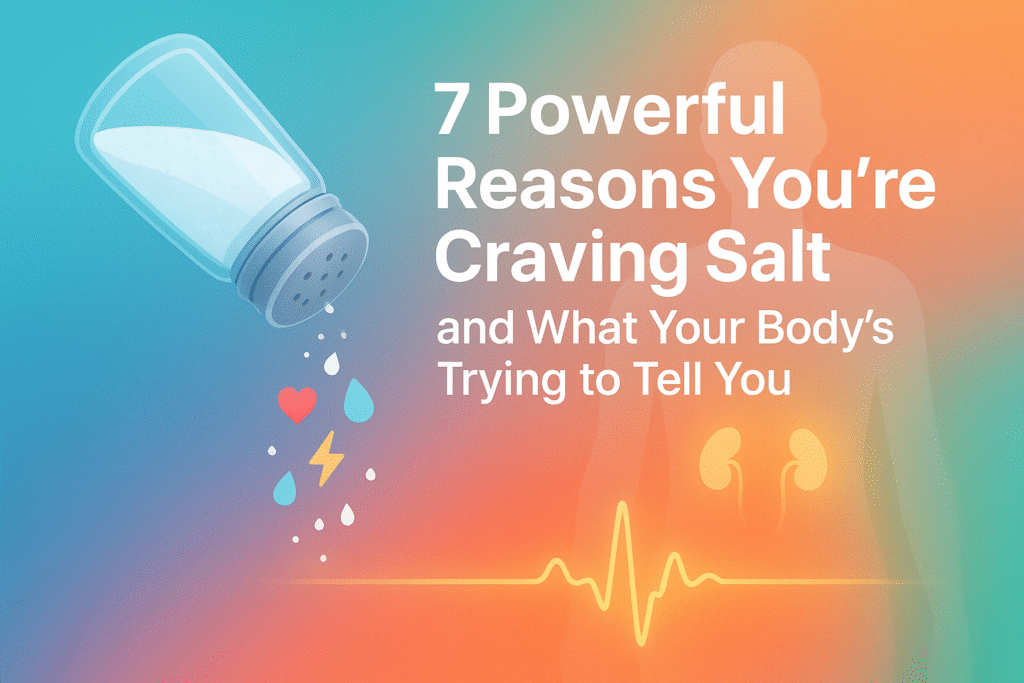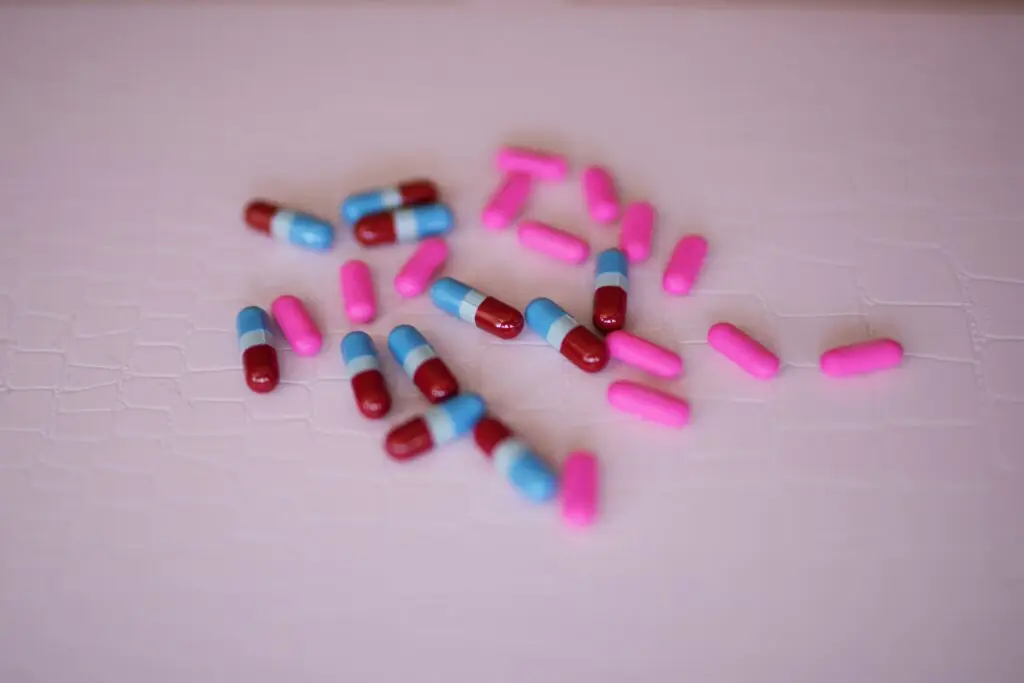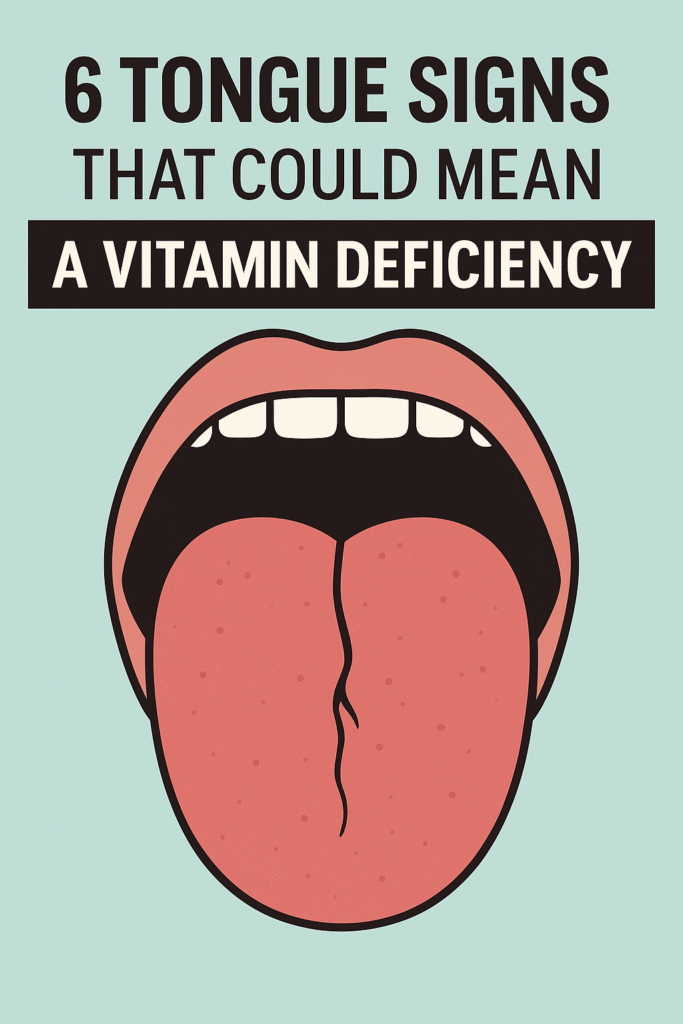
⚠️ Affiliate Disclaimer: This post may contain affiliate links, which means I may earn a small commission — at no extra cost to you — if you make a purchase through one of these links. I only recommend products or services I genuinely trust and believe can provide value. Thank you for supporting My Medical Muse!
7 Powerful Reasons Why You Are Craving Salt and What Your Body Is Trying To Tell You
If you find yourself reaching for chips, salted nuts, or adding extra pinches of salt to your food all the time, you’re not alone. Many people experience persistent salt cravings, and while it can seem harmless, your body might actually be trying to tell you something important.
Salt or sodium chloride is essential for maintaining fluid balance, nerve signaling, and muscle function, but when your craving becomes constant or unusually strong, it may reflect an imbalance in hydration, hormones, or underlying health conditions. In this comprehensive guide, we’ll explore the medical, physiological, and lifestyle reasons behind salt cravings, what they mean, and when they may indicate a deeper problem.
1. Dehydration: Your Body’s First Signal for Salt
One of the most straightforward and physiologically valid reasons you may crave salt is dehydration. When your body loses fluids through sweat, urination, vomiting, or diarrhea, it also loses critical electrolytes. especially sodium, because sodium plays a central role in fluid balance, your body triggers salt cravings to help restore equilibrium.
Why It Happens
Sodium is essential for maintaining the osmotic balance between the inside and outside of your cells. When you become dehydrated, your blood sodium concentration begins to fall, a condition known as hyponatremia. As sodium levels drop, water moves into your cells to balance concentrations, causing them to swell.
This process can interfere with normal nerve and muscle function, leading to symptoms such as fatigue, dizziness, confusion, or muscle cramps. The brain interprets this imbalance as a need for more salt and drives you to seek salty foods or drinks.
You Might Notice:
- Persistent thirst or dry mouth
- Headaches or light sensitivity
- Muscle cramps during or after physical activity
- Dizziness or faintness, especially after exertion or heat exposure
- Reduced urine output or dark-colored urine
What to Do
The best remedy is to rehydrate gradually. Start with plain water, and if you’ve lost a significant amount of fluid (such as after exercise or illness), use an oral rehydration solution or electrolyte drink to replenish sodium and potassium levels.
Avoid the common mistake of consuming large amounts of salt without adequate water, excessive sodium without fluid replacement can worsen dehydration and place additional stress on your kidneys and cardiovascular system. A good rule of thumb, rehydrate with fluids first, then restore electrolytes in moderation through balanced foods like soups, broths, or lightly salted snacks.
2. Adrenal Fatigue or Addison’s Disease
If salt cravings persist even when you’re well-hydrated, the cause may lie deeper in your adrenal glands. These small, triangular glands sit on top of each kidney and are responsible for producing hormones such as cortisol, aldosterone, and adrenaline.
Aldosterone, in particular, helps your body maintain sodium and potassium balance by regulating how much salt your kidneys conserve or excrete. When adrenal function is impaired as in Addison’s disease (primary adrenal insufficiency) or secondary adrenal insufficiency, your body loses too much sodium through urine. The resulting low sodium levels stimulate powerful salt cravings.
Why Salt Craving Occurs
Low aldosterone production reduces sodium reabsorption in the kidneys. As sodium levels fall, blood pressure and blood volume drop, to compensate, your body increases the drive to consume salt, an instinctive mechanism to restore sodium balance and improve circulation.
This is why individuals with adrenal insufficiency often report an intense, ongoing desire for salty foods, even without dehydration or exercise.
Symptoms Often Include:
- Chronic fatigue and muscle weakness
- Low blood pressure, especially when standing (orthostatic hypotension)
- Unexplained weight loss or poor appetite
- Darkening of the skin, particularly in Addison’s disease
- Nausea, abdominal discomfort, or vomiting
- Salt cravings that seem constant and strong
What to Do
If you suspect an adrenal issue, professional evaluation is essential. Your doctor will likely order:
- Blood tests for cortisol, ACTH, and electrolytes
- ACTH stimulation test to assess adrenal response
- Imaging of the adrenal glands if indicated
Treatment usually involves hormone replacement therapy (hydrocortisone or fludrocortisone) and careful sodium management under medical supervision, without treatment, Addison’s disease can progress to Addisonian crisis, a life-threatening condition marked by severe dehydration, dangerously low blood pressure, and electrolyte imbalance. Recognizing persistent salt cravings alongside fatigue or low blood pressure can help catch adrenal insufficiency early.
3. Hormonal Fluctuations: Menstrual Cycle, Pregnancy, or Menopause
Hormonal changes have a direct influence on both fluid regulation and taste perception, which is why many women experience fluctuations in salt cravings during different life stages particularly the menstrual cycle, pregnancy, and menopause. These cravings are typically linked to shifts in estrogen and progesterone, which can affect kidney function, water retention, and sodium balance.
During PMS (Premenstrual Syndrome)
In the days leading up to menstruation, estrogen and progesterone levels rise and fall sharply. These hormones influence how the body retains fluid and regulates sodium. When hormone levels drop just before menstruation, some women experience bloating, mood swings, and strong cravings for salty foods.
Your body may interpret these hormonal shifts as a need for sodium to stabilize fluid balance and relieve bloating, even though excessive salt may worsen it.
Key takeaway: mild salt cravings before your period are normal, but if you experience swelling, headaches, or blood pressure spikes, your sodium intake might need adjusting.
During Pregnancy
Pregnancy dramatically increases blood volume by as much as 40-50%. To accommodate this, your body requires more sodium to help retain enough fluid to support both maternal and fetal circulation.
Additionally, morning sickness and vomiting can lead to dehydration and sodium loss, which further amplifies cravings. Some pregnant women also experience heightened sensitivity to taste and smell, making salty foods more appealing.
However, excessive salt intake during pregnancy should be avoided, as it can contribute to high blood pressure or preeclampsia. The goal is to maintain adequate sodium intake through nutrient-dense, balanced foods rather than processed snacks.
Smart sources include: homemade soups, whole-grain crackers, or lightly salted nuts, all of which provide electrolytes without excessive sodium.
During Menopause
As estrogen levels decline in menopause, renal and adrenal functions undergo subtle changes. Reduced estrogen can lower fluid retention and affect aldosterone regulation, sometimes causing mild sodium loss and corresponding salt cravings.
Furthermore, menopausal women often experience fatigue, stress, and changes in cortisol levels, which may also increase the drive for salty comfort foods.
Best approach:
- Stay hydrated throughout the day.
- Focus on foods rich in magnesium and potassium (leafy greens, beans, avocado) to support electrolyte balance.
- If salt cravings come with bloating, swelling, or elevated blood pressure, consult your doctor to rule out cardiovascular or renal issues
Hormonal salt cravings are your body’s adaptive response to internal shifts in fluid and electrolyte dynamics. They usually don’t indicate a disease but rather a temporary physiological need. Still, when salt cravings are accompanied by fatigue, blood pressure changes, or persistent bloating, it’s best to have a medical evaluation to rule out underlying endocrine or circulatory disorders.
4. Low Sodium Levels (Hyponatremia)
Your body carefully maintains blood sodium within a narrow range typically 135-145 mEq/L. Sodium is essential for controlling fluid movement between cells, maintaining blood pressure, and supporting muscle and nerve activity. When sodium levels fall below this range, the condition is known as hyponatremia, and one of the earliest warning signs can be a strong craving for salt.
Why It Happens
Hyponatremia occurs when there’s either too much water relative to sodium in the body or significant sodium loss through fluids. This dilution effect disrupts normal cellular function, particularly in the brain, leading to neurological symptoms.
Common Causes Include:
- Overhydration: Excessive water intake without electrolyte replacement, especially during endurance sports
- Diuretic medications: Used for high blood pressure or heart failure, which increase sodium loss through urine
- Gastrointestinal losses: From prolonged vomiting, diarrhea, or severe sweating
- Kidney, liver, or heart disease: Conditions that impair fluid and sodium regulation
Symptoms:
- Persistent headaches or dizziness
- Nausea and vomiting
- Fatigue, confusion, or irritability
- Muscle weakness or cramps
- Seizures or loss of consciousness in severe cases
What to Do
Hyponatremia is a medical condition, not something to fix by eating more salt casually. Mild cases may respond to reducing excess fluid intake and modestly increasing sodium under supervision. Severe cases require urgent hospital treatment with controlled IV saline infusion to restore sodium safely.
Never attempt to self-correct by consuming large amounts of salt raising sodium levels too rapidly can cause serious neurological damage (osmotic demyelination). Always seek medical advice if you suspect low sodium, especially if symptoms like confusion or weakness develop.
5. Chronic Stress and Fatigue
Craving salt during periods of stress is not purely psychological, it’s rooted in the body’s stress response system. Chronic or prolonged stress activates the hypothalamic-pituitary-adrenal (HPA) axis, increasing secretion of cortisol, the primary stress hormone. Cortisol affects how your body retains sodium and regulates blood pressure.
Why It Happens
Under normal circumstances, cortisol and aldosterone (another adrenal hormone) work together to conserve sodium and maintain stable blood pressure. When stress is ongoing, the adrenal glands become overworked, and the delicate balance of these hormones can shift. Over time, aldosterone production may drop, causing excessive sodium loss in urine, which triggers the body’s instinct to crave salty foods to compensate.
You May Notice:
- Fatigue, mental fog, or dizziness that improves after salty foods
- Afternoon or evening salt cravings, especially after long, stressful workdays
- Low energy that temporarily lifts after eating processed or salty snacks
What to Do
To manage stress-related salt cravings:
- Prioritize rest: Adequate sleep restores hormonal balance.
- Practice relaxation techniques: Like deep breathing, meditation, or light exercise to lower cortisol levels.
- Eat balanced meals: Containing complex carbohydrates, healthy fats, and protein to maintain steady energy levels.
- Include mineral-rich foods: Such as spinach, avocados, and nuts to replenish electrolytes naturally.
Avoid using salt or salty snacks as an energy fix. The temporary “boost” often masks underlying fatigue or mild dehydration and can increase blood pressure over time.
6. Exercise and Electrolyte Loss
Regular exercise, particularly in hot or humid environments, increases sweat production. Sweat contains both water and electrolytes primarily sodium and chloride which are vital for muscle contraction and nerve signaling. When these electrolytes are lost faster than they’re replaced, your body naturally begins craving salt to restore balance.
Why It Happens
During intense or prolonged physical activity, sodium loss through sweat can exceed 1-2 grams per hour, depending on genetics, fitness level, and climate. As blood sodium concentration falls, the brain’s hypothalamus stimulates thirst and salt appetite to maintain normal osmotic pressure.
Signs This Applies to You:
- White salt residues on workout clothes or skin after exercise
- Frequent muscle cramps or spasms during training
- Dizziness, lightheadedness, or fatigue after prolonged activity
- Headaches or nausea following heavy sweating
What to Do
- Hydrate strategically: For workouts under one hour, water is usually sufficient. For longer or high-intensity sessions, use electrolyte-enhanced fluids containing sodium, potassium, and magnesium.
- Replenish electrolytes naturally: Combine sodium sources (soups, broth, lightly salted nuts) with potassium-rich foods (bananas, oranges, spinach).
- Avoid overcompensation: Excessive salt intake post-exercise can lead to bloating, elevated blood pressure, or water retention.
Athletes or individuals in hot climates should discuss tailored hydration and sodium replacement plans with a sports medicine specialist or dietitian.
7. Nutrient Deficiencies and Dietary Imbalance
Not all salt cravings stem from sodium loss, sometimes, they arise from broader nutrient deficiencies or dietary habits that alter taste perception, fluid balance, or metabolism.
Magnesium Deficiency
Magnesium helps regulate other electrolytes, including sodium, potassium, and calcium. A deficiency can cause muscle cramps, fatigue, and irregular cravings for both salt and sugar, as the body struggles to stabilize nerve and muscle function.
Zinc Deficiency
Zinc is essential for maintaining healthy taste buds. When levels are low, foods may taste dull or bland, prompting you to add more salt for flavor. Over time, this can desensitize your palate, creating a feedback loop of stronger salt cravings.
Other Dietary Links
- Low-Carbohydrate or Ketogenic Diets: These eating patterns reduce insulin levels, which in turn increase sodium excretion through the kidneys. This physiological sodium loss can manifest as cravings, dizziness, or fatigue, especially in the early adaptation phase.
- Highly Processed Diets: Regular consumption of processed foods trains your taste buds to prefer stronger salty flavors. When you switch to whole foods, meals may initially taste “flat,” leading to perceived cravings.
What to Do
- Focus on whole, minimally processed foods: fresh vegetables, fruits, lean proteins, and whole grains.
- Use moderate amounts of natural salts like sea salt or rock salt to season meals without overdoing it.
- Include magnesium- and zinc-rich foods, such as leafy greens, legumes, seeds, seafood, and whole grains.
- If salt cravings persist despite balanced nutrition, consult your healthcare provider for micronutrient testing to check for deficiencies.
Balancing your mineral intake and re-sensitizing your taste buds over time can dramatically reduce unnecessary salt cravings and improve overall cardiovascular health.
Medications That Affect Sodium Balance
Certain drugs can interfere with sodium regulation or increase sodium loss, indirectly causing cravings.
Examples include:
- Diuretics (used for high blood pressure or swelling)
- Corticosteroids
- SSRIs and antidepressants
- Chemotherapy agents
How they cause salt cravings:
These medications can either deplete sodium or alter how your kidneys retain it, making you unconsciously compensate through diet.
What to do:
If your cravings began after starting a new medication, discuss this with your doctor. Never adjust prescriptions on your own.
Underlying Medical Conditions
In rare cases, persistent salt cravings can be an early sign of underlying medical problems, such as:
- Cystic Fibrosis:
Causes excessive salt loss through sweat, especially in children. - Postural Orthostatic Tachycardia Syndrome (POTS):
A condition affecting blood circulation where increasing salt intake can help stabilize blood pressure. - Bartter’s or Gitelman’s Syndrome:
Kidney disorders that cause chronic electrolyte imbalance. - Hypothyroidism:
Low thyroid activity may influence adrenal and fluid balance, indirectly increasing salt cravings.
If salt cravings are accompanied by fatigue, dizziness, heart palpitations, or unexplained weight changes, medical evaluation is essential.
Psychological or Habitual Factors
Not all salt cravings are biological. Sometimes, it’s a learned or comfort-driven habit.
Highly processed foods: Chips, fries, sauces, and snacks, stimulate dopamine release, giving you a mild reward sensation. Over time, your brain associates salt with pleasure and comfort, not need.
What to do:
- Gradually reduce sodium in cooking.
- Use herbs, lemon, or vinegar for flavor instead.
- Reset your taste buds within 2-3 weeks, your body adapts to lower salt levels.
When to See a Doctor
Occasional salt cravings are normal, especially after sweating or dehydration. However, persistent or intense cravings, especially when accompanied by other symptoms, warrant medical review.
See your doctor if you experience:
- Fatigue, muscle weakness, or dizziness
- Salt cravings despite adequate hydration
- Low blood pressure or fainting spells
- Unexplained weight loss
- Darkening of skin or chronic nausea
Your doctor may order tests for electrolyte levels, adrenal function, thyroid function, or kidney health.
How to Manage Salt Cravings Safely
- Stay hydrated properly: Aim for consistent water intake with balanced electrolytes.
- Check your diet: Ensure adequate magnesium, potassium, and zinc.
- Moderate salt intake: Prefer natural salts (sea salt, rock salt) but within recommended limits (2,300 mg sodium/day).
- Identify triggers: Note if cravings occur during stress, exercise, or specific cycle phases.
- Limit processed foods: Hidden sodium sources can desensitize your palate.
- Monitor your health: Persistent cravings could reflect adrenal, thyroid, or kidney issues.
Final Thoughts
Craving salt isn’t always about taste, it’s often a subtle signal from your body. While mild salt cravings can result from sweating, exercise, or hormonal fluctuations, constant or intense urges for salty foods can point to underlying health issues like dehydration, adrenal imbalance, or low sodium levels.
The key is listening to your body, understanding when a craving is normal versus when it’s a call for medical attention, with mindful nutrition, hydration, and awareness of your body’s patterns, you can manage salt cravings safely and maintain long-term balance.
👩⚕️ Need Personalized Health Advice?
Get expert guidance tailored to your unique health concerns through MuseCare Consult. Our licensed doctors are here to help you understand your symptoms, medications, and lab results—confidentially and affordably.
👉 Book a MuseCare Consult NowRelated Blog Post You Might Like:
- Why Your Heartbeat Slows Down Suddenly While Walking: 7 powerful Reasons Explained
- Why Do I Feel Full but Still Hungry? 11 Powerful Reasons Explained
- Why Does My Face Gain Weight Before My Body: 7 Surprising Reasons
- Why Do I Crave Peanut Butter Late at Night? 7 Shocking Reasons Explained
- 7 Powerful Everyday Causes Why You Crave Ice or Crunchy Foods
- 10 Proven Ways to Reduce Swelling in Ankles at the End of the Day


